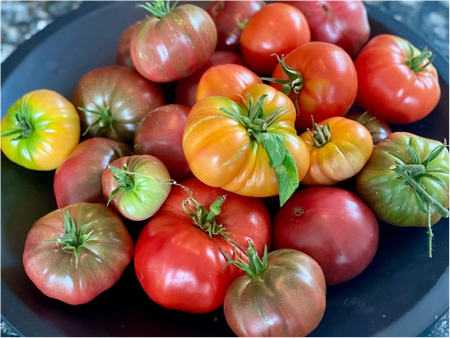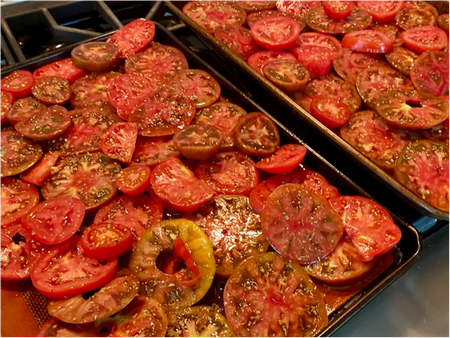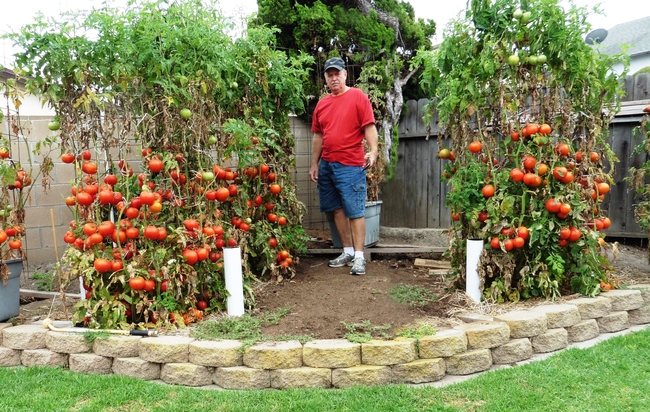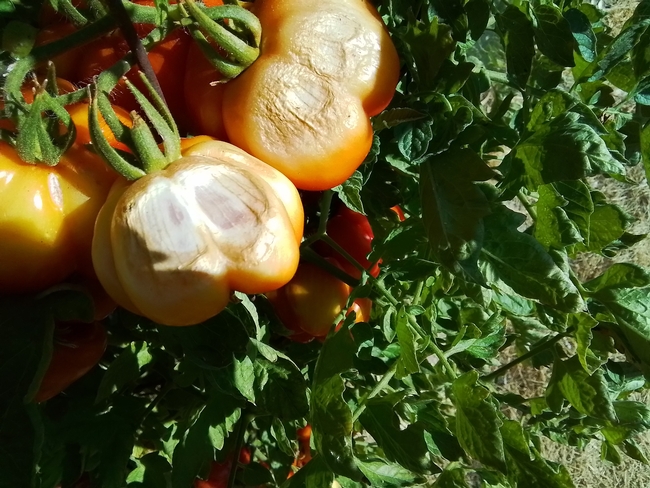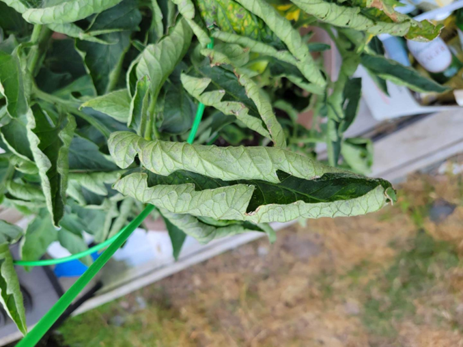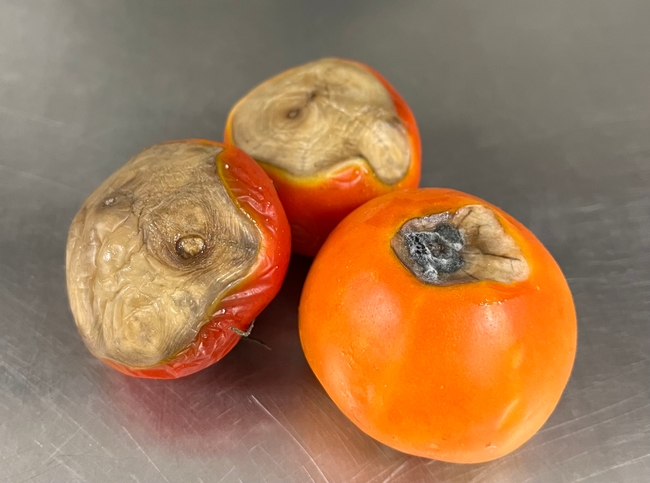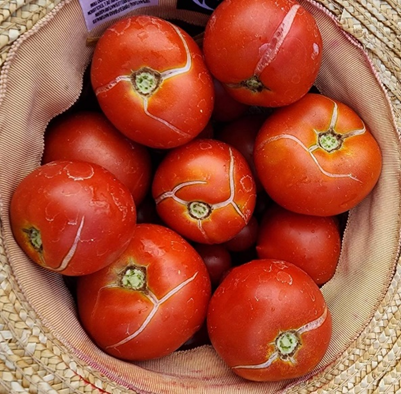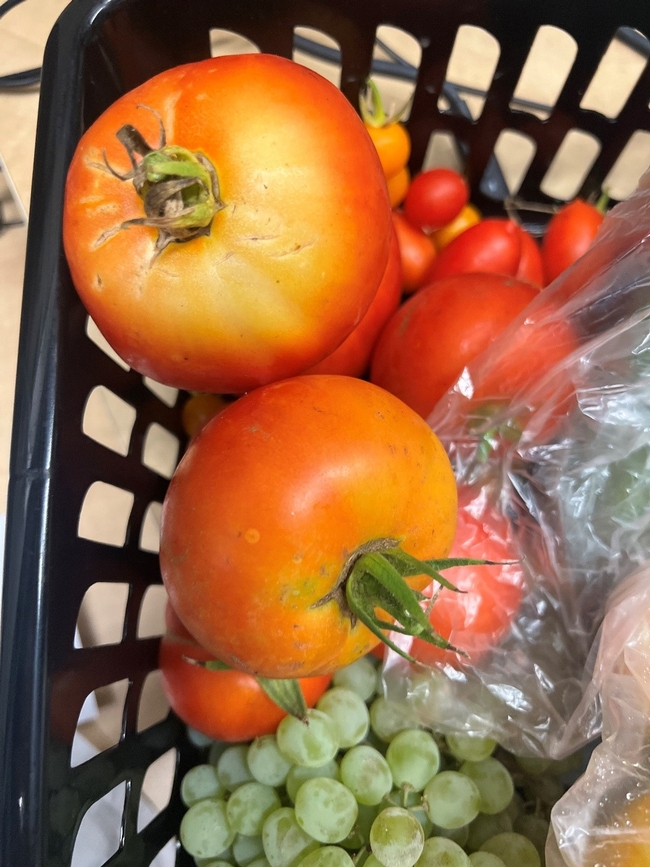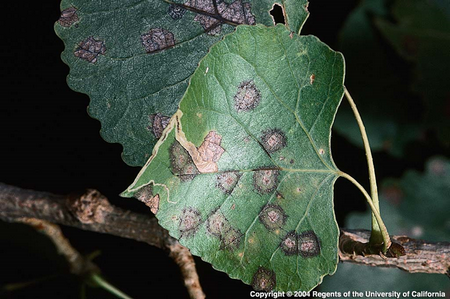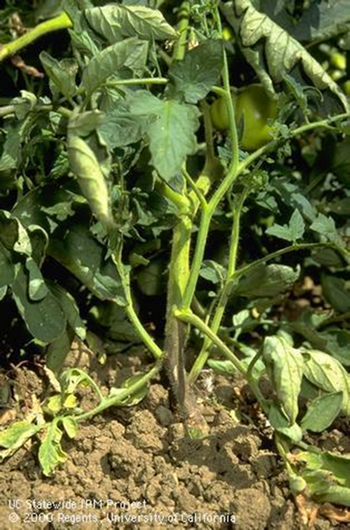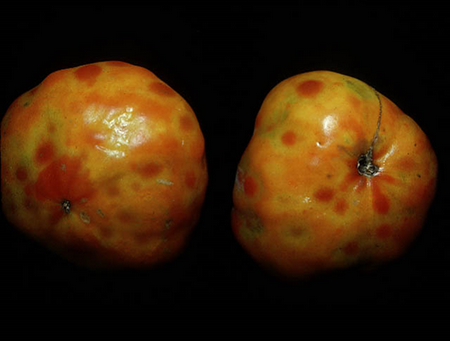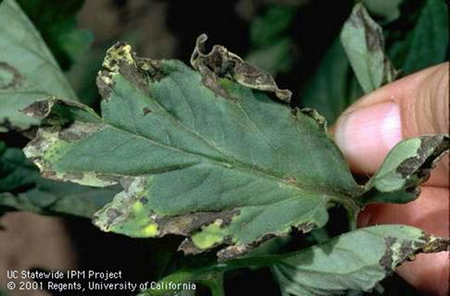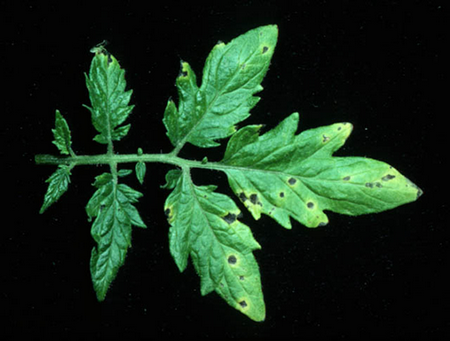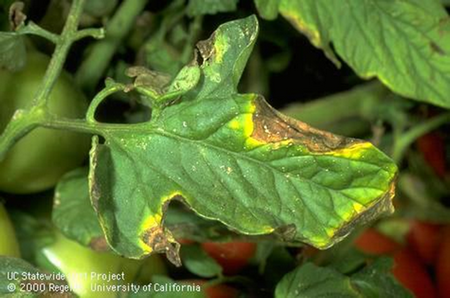Posts Tagged: tomatoes
Are Your Tomatoes Feeling the Heat?
It's hot. Tomatoes like heat, right? Actually, tomatoes like warm weather, between 65 and 85 degrees. When temperatures soar past 95, tomatoes stop growing. In that kind of heat, their flowers fail to pollinate and instead they dry up and drop off,...

Healthy tomatoes on the vine. Maureen Matt
Lawn-pocalypse! Surviving Drought
Ah, summer! The season of sunburns, pool parties, and… lawn droughts. If your once lush, green carpet now looks like a crunchy brown doormat, you're not alone. Let's dive into why your yard is staging a dramatic death scene and what you can do to...

Bermuda grass and weeds overtaking drought stressed turf grass.
You Can't Choose a Bad Tomato
The 2024 Great Tomato Plant Sale is just around the corner, from April 13 to April 27, in three locations this year: Walnut Creek, Antioch and Richmond. This year's sale will feature 67 varieties of tomatoes chosen not only for flavor, but also for their ability to thrive in our Contra Costa County climate. Whether you're growing in beds or containers, in the heat of East County, the cool fog of West County, or somewhere in between, the Great Tomato Plant Sale will have a variety that will work great for you!
With so many choices, how do you know where to start? One possibility is to think about how you plan to use your tomatoes. Do you want to eat them straight off the vine? Do you imagine using them in fresh salads or hearty sandwiches? Maybe you want to make sauce or tomato paste, or are thinking about roasting, canning, or frying them. For those of you with certain culinary goals in mind, remember that tomatoes can be specialists. Each has its own unique flavor ranging from sweet and fruity to acidic and tangy. Some are meaty, some juicy, some sturdy enough to slice for a sandwich. Here are some of our favorites.
Fresh Snacks
Pop them in your mouth as “garden candy” or add to a salad or skewer. Cherry and grape tomatoes or small fruited slicer tomatoes are perfect for bite-sized snacks, kebabs, or including on a vegetable tray.
• Orange Paruche—it glows a brilliant, neon orange. One inch round fruits are thin-skinned and crack-and-disease-resistant with a superb flavor.
• Black cherry—dusky purple-brown grape-like 1” tomatoes with a rich, complex flavor.
• Sun sugar—very sweet, fruity-tasting orange cherry tomatoes in long clusters on vigorous plants.
• Tommy Toe—bright red and prolific with excellent flavor and plenty of juice.
• Yellow pear—wonderful in salads or as garden candy with a delightfully sweet flavor.
Salads and Sandwiches
Slicers, some heirloom tomatoes, and beefsteak tomatoes all have varieties that are delicious when eaten fresh. Their high water content means they are not the best for cooking, but they hold together well, making them ideal for sandwiches. And they come in a variety of colors to add exuberance to a salad such as the Caprese. Your choices will depend primarily on your growing conditions and your personal flavor preferences.
• Early Girl—4- to 6-ounce, bright crimson fruits with a tangy flavor.
• Black Sea Man—produces early and does well in containers. With attractive marbled flesh and a rich flavor.
• Aunt Ruby's Green—1 pound lime to yellow-green fruit with a superb fruity, slightly tangy taste.
• Caspian Pink—an incredibly sweet and juicy fruit that can reach one pound or larger. Great either fresh or cooked.
• Chocolate Stripe—these large tomato plants yield a big crop of mahogany colored fruit with dark, olive green-striping.
• Paul Robeson—7- to 10-ounce, blackish brick-red fruits with a sweet and smoky flavor.
Sauce, Paste and Canning
Look for thick flesh, rich flavor, tender texture, mild acidity, and low water content. These tomatoes, often known as paste tomatoes, have been developed for sauces. They peel easily and cook well, making a thick and delicious sauce quickly. Varieties include Roma and the famous Italian cooking tomato, San Marzano.
• Granadero—attractive, bright red, 4- to 5-ounce tomatoes with very good flavor. These thick-walled fruits are ideal for fresh tomato sauces, salsas, and salads.
• La Roma III—high yields of 5- to 8-ounce plum tomatoes on healthy, disease resistant and vigorous vines.
• Big Mama—5-inch-long paste tomatoes that are meaty, easy to peel and have very few seeds.
• San Marzano—solid flesh is perfect for canning/freezing for rich pasta sauce all winter.
Roasting, Salsa
Have you ever wanted to make your own salsa? Perhaps roasting cherry tomatoes or topping tomato slices with parmesan cheese sounds like something you'd enjoy. Paste tomatoes make great salsa and all tomatoes can be roasted. Experiment, mix different types, roast and then puree them with the skins on. Toss them in with pasta, use them for sauce, or can them for next winter when you miss the flavors of summer.
You Can't Go Wrong
There's a lot more to learn about tomatoes. Some will fare better than others in the dry heat of East County; others will thrive in the cooler climate of West County. If you have limited space, try cherry tomatoes in containers or a compact determinate (bush) variety. If you want the harvest to spread out all summer, choose an array of varieties with different ripening dates, or grow indeterminate (vine) tomatoes which tend to produce all summer. Our website explains all the differences, and even provides a shopping list for planning. https://ccmg.ucanr.edu/EdibleGardening/GreatTomatoPlantSale/
Remember, you can't choose a bad tomato. Experiment and have fun!
All photos courtesy of Pamela Schroeder, Master Gardener and tomato lover.
Help Desk of the UC Master Gardeners of Contra Costa County (RDH)
Bring on the Tomatoes! 5 Common Tomato Problems and Solutions
Almost any home gardener will tell you that one of the most versatile and rewarding plants to grow in a summer edible garden is a tomato. In fact, a 2023 study by the National Gardening Association revealed that 86 percent of gardeners grow tomatoes. It is understandable that the tomato plant is a popular home vegetable garden staple, tomatoes offer thousands of different varieties options and flavors. Plus, nothing beats the bursting flavor of a ripe tomato straight from the garden.
When properly cared for, a single tomato plant can produce 10 to 15 pounds (4.5 to 6.8 kg) or more of fruit. As with any gardening journey, sometimes there can be obstacles or challenges to overcome. If tomato yields aren't what was expected, or the fruit is damaged, it could be due to a number of abiotic disorders, diseases or pesky pests.
Abiotic disorders result from non-living causes and are often environmental, for example: unfavorable soil conditions, too much or too little water, extreme temperature, physical or chemical injuries, and other issues that can harm or kill a plant. Using research-based information from UC Agriculture and Natural Resources (UC ANR) publication, Growing Tomatoes in the Home Garden.
Here are five of the most common abiotic disorders of tomatoes and how to address them:
- Sunburn or Sunscald: Yes, just like humans tomatoes can also suffer from sunburns because of overexposure to the sun. Sunburnorsunscald occurs on the side of the fruit exposed to the sun, which turns brown and becomes leathery in texture. Solutions:
- Maintain the plant canopy to produce adequate leaf cover for the fruit.
- Avoid overpruning.
- Provide partial shade during peaks sunlight hours.
- Leaf Roll: You might find that the older leaves on your plant suddenly roll upward and inward, becoming stiff, brittle and tough to the touch. This is typically caused by high light intensity and moist soil, especially in staked and heavily pruned plants. Solutions:
- Choose less-susceptible varieties.
- Maintain even soil moisture.
- Provide partial shade during peaks sunlight hours.
- Blossom End Rot: This condition appears as a water-soaked spot at the blossom end of the fruit, which enlarges and darkens, creating a sunken, leathery appearance. It's more prevalent in sandy soils and is primarily caused by calcium nutrition imbalance and inconsistent water levels. Solutions:
- Maintain even soil moisture.
- Amend planting area with compost to improve water retention.
- Avoid heavy applications of high-nitrogen fertilizer.
- Soils deficient in calcium may be amended with gypsum.
- Fruit Cracks and Catfacing: Rapid growth during high temperatures and excessive soil moisture can lead to circular concentric cracks around the stem end, radial cracks shooting out from the stem, and malformation and cracking at the blossom end, a phenomenon known as ‘catfacing'. Solution:
- Keep soil evenly moist.
- Maintain good leaf cover or provide partial shade during hours of most intense sunlight.
- Mulch around the plant 3 to 7 inches deep to maintain soil moisture and temperature.
- Solar Yellowing and Green Shoulders: This problem is marked by the tomato turning yellow or yellow-orange instead of the normal red color, with the upper part of the fruit stubbornly staying green even though the lower part appears red and ripe. It's a result of high temperatures and intense light. Solutions:
- Maintian plant vigor to produce adequate leaf cover.
- Avoid overpruning.
- Provide partial shade during hours of most intense sunlight.
A variety of insects and pests can cause other damage to tomato plants. Some examples of common pests, include: hornworms, tomato fruitworms, tomato pinworms, stink bugs, white flies, and leafminers. For information about identifying and managing pests in your edible garden visit the UC Integrated Pest Management (UC IPM) website, ipm.ucanr.edu.
Navigating the ups and downs of growing tomatoes might seem daunting, but don't forget, every seasoned gardener has been in your shoes once. We've explored the common abiotic diseases and challenges you might encounter in your tomato-growing journey, and hopefully armed you with solutions to keep these issues at bay.
If you have additional questions or need more help, don't hesitate to reach out to your local UC Master Gardener Program. We have a team of volunteers trained and eager to help you have a bountiful harvest! mg.ucanr.edu/FindUs
Source: Growing Tomatoes in the Home Garden Publication 8159 http://anrcatalog.ucanr.edu/pdf/8159.pdf
Tomato Diseases in the Home Garden
As tomato growers, we might consider any ailing tomato to have a disease. That would end up making this blog post really, really long. However, we need to consider diseases separately from damage done by pests (both vertebrate and invertebrate—see blog post from July 18: Tomato Diseases in the Home Garden) or environmental disorders such as blossom end rot (see blog post from July 4: https://ucanr.edu/blogs/blogcore/postdetail.cfm?postnum=57297). We will cover fungal, viral, and bacterial diseases here.
Fungal
The most common tomato diseases are fungal. Many of these fungal spores are nearly everywhere all the time, and given the right conditions, will find a home on your tomato plants. Some fungi prefer cool conditions while some prefer warm. Most prefer wetness and high humidity. Crowding can prevent proper air circulation and encourage fungal diseases. Nutritional deficiencies and injuries also encourage fungal diseases.
Damping Off Disease typically affects seedlings. It's caused by various soil fungi that grow under damp conditions. The affected tap roots of seedlings in contaminated, overly damp soil are dark and mushy and the seedlings usually die. Prevent this by using fresh clean soil and sanitized containers with good drainage. Use alcohol or a 10% bleach solution to sanitize. https://ipm.ucanr.edu/PMG/PESTNOTES/pn74132.html
Septoria Leaf Spot is favored when plants are exposed to cool, rainy weather or splashing from soil. It's relatively uncommon in Contra Costa County. Prune off infected leaves and twigs and keep plants dry. https://ipm.ucanr.edu/PMG/GARDEN/PLANTS/DISEASES/septorialfspot.html
Phytophthora Root and Crown Rot is a soil-borne fungus-like organism transmitted under wet conditions by splashing water or contaminated garden debris, pots, or tools. Plants appear drought-stressed since the vascular system is compromised, and often die. It can also cause damping-off. Look for darkening of the crown, roots, and stems. Good drainage, avoiding overwatering, and sanitizing any tools used on the diseased plants are preventive measures. In previously affected soil, avoid planting members of the Solanaceae family (tomatoes, eggplant, peppers, potatoes) in the infected soil and plant a resistant crop instead such as corn. https://ipm.ucanr.edu/PMG/PESTNOTES/pn74133.html
White Mold, also called Cottony Soft Rot, appears as bleached areas on stems from white mycelia. Fruit can be affected and appears gray. The mold favors hot, moist conditions and often spreads from dying flowers. Bury or dispose of infected tissue; avoid overhead watering, overwatering, and crowding. https://ipm.ucanr.edu/PMG/GARDEN/VEGES/DISEASES/tomwhmold.html
Powdery Mildew looks different on artichoke, pepper, and tomato leaves from its appearance on other plants (see reference). It requires warm weather and living tissue to grow but does not require moist conditions. Prevention includes planting resistant varieties in sunny areas and avoiding crowding. Occasionally a fungicide or a biologic is needed. https://ipm.ucanr.edu/PMG/PESTNOTES/pn7406.html
Early Blight's name is somewhat misleading as it occurs on mature tomato plants and can affect fruit. It is uncommon in our Mediterranean climate. See reference for photos, prevention, and treatment: https://ipm.ucanr.edu/PMG/GARDEN/VEGES/DISEASES/tomearlyblight.html
Late Blight (Phytopthora infestans) occurs in our coastal areas and is favored by average temperatures and high humidity. It can spread rapidly from other Solanaceae family members or their cullings. Avoid overhead sprinkling and crowding of plants and buy certified blight-free seeds and tubers. Dispose of affected plants and debris in green waste. https://ipm.ucanr.edu/PMG/GARDEN/VEGES/DISEASES/lateblight.html
Black Mold typically affects ripe tomato fruit during conditions of warmth and high humidity. It can appear as small dark brown spots or grow into large, sunken areas. Pick fruit as soon as it ripens. https://ipm.ucanr.edu/PMG/GARDEN/VEGES/DISEASES/tomblkmold.html
Verticillium and fusarium wilt are fungal diseases that will be discussed in an upcoming blog.
Viral
Tobacco Mosaic Virus is a disease primarily of Solanaceae, of which tobacco is a member. It is transmitted by infected seeds or by tobacco residue on the hands of smokers. The leaves appear mottled and stringy, but the fruit is edible. Herbicide damage can appear similar. Many tomato cultivars have resistance. https://ipm.ucanr.edu/PMG/GARDEN/VEGES/DISEASES/tobaccomosvir.html
Curly Top Virus and Spotted Wilt Virus are fairly unusual afflictions. Curly Top Virus is carried by the beet leafhopper and causes curling, puckering, and stunting of leaves. Fruit is usually discolored and small. Spotted Wilt Virus is transmitted by the western flower thrip. It can be difficult to diagnose as it presents differently depending on the stage of plant growth. Fortunately, it's rare in Contra Costa County. Both have wide host ranges. For severe infections in the garden, testing may be warranted since the viruses can mimic other diseases. Affected plants will need to be removed and disposed of. Unfortunately, insecticides do not kill thrips or leafhoppers in time once the damage has been noticed. https://ipm.ucanr.edu/PMG/GARDEN/VEGES/DISEASES/curlytop.html
https://ipm.ucanr.edu/PMG/GARDEN/VEGES/DISEASES/tomspotwltvir.html
Bacterial
Bacterial Speck, Bacterial Spot, and Bacterial Canker are all easily confused. They tend to be introduced on infected seeds, and can overwinter on garden debris, flats, and stakes. They all prefer wet conditions. All three cause lesions on fruit. Speck and Spot cause similar leaf lesions and are chiefly distinguished by their appearance on fruit.
Bacterial Speck prefers cooler conditions such as in coastal regions. A Pseudomonas bacterium causes small sunken spots with white halos that can become scabby. The leaf spots are similar and appear greasy, and leaf margins can turn brown in an angular pattern. Stems can also be affected.
Bacterial Spot is caused by Xanthomonas bacteria, resulting in large, black, sunken spots on fruit and irregular black spots on leaves. Warm, humid conditions favor its appearance. The fruit may be eaten once the black spots and any underlying maceration are removed. https://u.osu.edu/vegetablediseasefacts/tomato-diseases/bacterial-leaf-spot/basics/
Bacterial Canker also prefers warm, humid conditions. Stunting, wilting, scorching of leaf margins, cankers on stems, and vascular discoloration are distinguishing features.
https://ucanr.edu/blogs/blogcore/postdetail.cfm?postnum=27926&postnum=27926
Bacterial diseases can be managed somewhat with copper sprays and these sprays are acceptable for organic farming.
Prevention
Prevention is the ideal way to manage all these diseases:
• Rotate crops
• Don't overwater or spray the plant
• Don't crowd plants
• Remove lower leaves that can touch the soil
• Use mulch to prevent spread from soil
• Buy resistant varieties
• Control weeds to prevent thrip and leafhopper invasions
• Dispose of infected plant parts and debris, sanitize tools, planting flats, and hands
• Baby heirloom tomatoes because they typically have little resistance
For more information about pests and diseases of tomatoes, see this website: https://ipm.ucanr.edu/home-and-landscape/tomato/index.html
Help Desk of the UC Master Gardeners of Contra Costa County (EAS)

